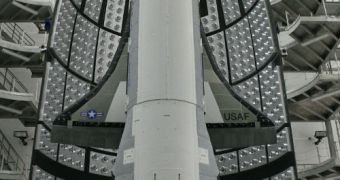The X-37B prototype space plane that was launched by the United States Air Force (USAF) earlier this year has changed orbit again, forcing amateur astronomers in a frenzy to locate it again.
This has been their goal ever since the USAF launched the hush-hush project, details of which are classified. Satellite trackers and backyard astronomers have been scouring the skies for the plane.
The Boeing-designed X-37B spacecraft is an unmanned robot, which is capable of remaining in Earth's orbit for prolonged periods of time. It was launched this April 22.
Take-off took place from the Cape Canaveral Air Force Station (CCAFS), in Florida, atop an Atlas V delivery system. Since being deployed, it has changed orbit several times.
According to experts, the space should be able to remain in orbit for as much as 270 days. Thus far, it spent around 175 days airborne, which means that there is life in its gallium arsenide solar panels still.
The change in orbit could mean one of three things, amateur astronomers say. The spacecraft may have changed its orbit, it may have carried out some experiments, or it may get ready to land.
All aspects of the craft are controlled from the ground, and the landing sequence is automated. The X-37B was designed so that it can land at either the Vandenberg Air Force Base (VAFB) or the Edwards Air Force Base (EAFB).
Both facilities are located in California. The NASA Dryden Flight Research Center is located at the EAFB as well, Universe Today reports.
The origins of the entire project can be traced back to NASA in 1999, experts say. By 2004, the Pentagon had taken it over, and classified most details about it.
“The X-37B Orbital Test Vehicle, or OTV, is a non-operational system that will demonstrate a reliable, reusable, unmanned space test platform for the US Air Force,” the spacecrafts official specs sheet says.
“The objectives of the OTV program include space experimentation, risk reduction and a concept of operations development for reusable space vehicle technologies,” it goes on today.
But many fear that the new platform in fact nothing more than an attempt to take weapons to low-Earth orbit (LEO) and beyond. Speculations about this are fueled by the fact that NASA was taken off the project.
China is especially concerned about the new test flights, and has made this known repeatedly and clearly.

 14 DAY TRIAL //
14 DAY TRIAL //